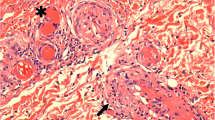Abstract
Purpose
Cryoglobulinemia is a pathological condition characterized by the presence of cryoglobulins in the blood, with cryoglobulinemic glomerulonephritis being the most frequent form of renal involvement. Fanconi syndrome presents as a generalized dysfunction of the proximal tubule, characterized by the presence of polyuria, phosphaturia, glycosuria, proteinuria, proximal renal tubular acidosis, and osteomalacia. We aimed to present five cases co-occurring with Fanconi syndrome and cryoglobulinemia.
Methods
We retrospectively summarized the cases of five patients with Fanconi syndrome and cryoglobulinemia at Peking Union Medical College Hospital from January 2012 to June 2022. The clinical features, diagnosis, treatment, and prognosis were systematically analyzed.
Results
All five patients exhibited typical features of Fanconi syndrome, and cryoglobulinemia was concurrently detected in all cases. These patients also exhibit positive anti-nuclear antibody spectrum and hyperglobulinemia, and IgM constitutes the predominant monoclonal component in cryoglobulins. In addition to supplemental treatment, timely immunosuppressive therapy may potentially benefit the long-term renal prognosis of patients with this condition.
Conclusion
Our findings highlight the rare co-occurrence of Fanconi syndrome and cryoglobulinemia in clinical practice. Despite the lack of causal evidence, the coexistence of Fanconi syndrome and tubulointerstitial injury is also noteworthy in patients with cryoglobulinemia, underscoring the importance of thorough evaluation and tailored management in patients presenting with overlapping renal manifestations.
Key Points • Patients with mixed cryoglobulinemia can clinically present with tubulointerstitial injury, specifically manifesting as Fanconi syndrome. • In addition to typical symptoms of Fanconi syndrome, these patients also exhibit positive anti-nuclear antibody spectrum and hyperglobulinemia, while IgM constitutes the monoclonal component in cryoglobulins. • Timely immunosuppressive therapy may improve long-term renal prognosis in these patients. |



Similar content being viewed by others
Data availability
All necessary data have been presented as tables and figures in the manuscript. Related information is accessible to the corresponding author upon request.
References
Brouet J-C et al (1974) Biologic and clinical significance of cryoglobulins: a report of 86 cases. Am J Med 57(5):775–788. https://doi.org/10.1016/0002-9343(74)90852-3
Desbois AC, Cacoub P, Saadoun D (2019) Cryoglobulinemia: an update in 2019. Joint Bone Spine 86(6):707–713. https://doi.org/10.1016/j.jbspin.2019.01.016
Foreman JW (2019) Fanconi syndrome. Pediatr Clin North Am 66(1):159–167. https://doi.org/10.1016/j.pcl.2018.09.002
Doshi M et al (2016) Paraprotein–related kidney disease: kidney injury from paraproteins—what determines the site of injury? Clin J Am Soc Nephrol 11(12):2288–2294. https://doi.org/10.2215/cjn.02560316
Beddhu S, Bastacky S, Johnson JP (2002) The clinical and morphologic spectrum of renal cryoglobulinemia. Medicine 81(5):398–409. https://doi.org/10.1097/00005792-200209000-00005
D’Amico G (1998) Renal involvement in hepatitis C infection: cryoglobulinemic glomerulonephritis. Kidney Int 54(2):650–671. https://doi.org/10.1046/j.1523-1755.1998.00028.x
D’Amico G et al (1989) Renal involvement in essential mixed cryoglobulinemia. Kidney Int 35(4):1004–1014. https://doi.org/10.1016/0002-9343(74)90852-3
Terrier B et al (2012) Management of noninfectious mixed cryoglobulinemia vasculitis: data from 242 cases included in the CryoVas survey. Blood 119(25):5996–6004. https://doi.org/10.1182/blood-2011-12-396028
Ren H et al (2008) Renal involvement and followup of 130 patients with primary Sjögrenʼs syndrome. J Rheumatol 35(2):278–284
Ferri C et al (2011) Treatment with rituximab in patients with mixed cryoglobulinemia syndrome: results of multicenter cohort study and review of the literature. Autoimmun Rev 11(1):48–55. https://doi.org/10.1016/j.autrev.2011.07.005
Pouchelon C et al (2022) Management of nonviral mixed cryoglobulinemia vasculitis refractory to rituximab: data from a European collaborative study and review of the literature. Autoimmun Rev 21(4):103034. https://doi.org/10.1016/j.autrev.2022.103034
Visentini M et al (2015) Efficacy of low-dose rituximab for the treatment of mixed cryoglobulinemia vasculitis: phase II clinical trial and systematic review. Autoimmun Rev 14(10):889–896. https://doi.org/10.1016/j.autrev.2015.05.013
Funding
This work was supported by the National High Level Hospital Clinical Research Funding under Grant [2022-PUMCH-B-020] (Y.Q), Sansheng Yeehong TCP Research Foundation (G.C), Bethune Charitable Foundation under Grant [J202103E006] (G.C.), and the Peking Union Scholars and Innovation Team Development Programme (2016) (X.L.).
Author information
Authors and Affiliations
Corresponding authors
Ethics declarations
Ethics approval
This study was approved by the Institutional Review Board of PUMCH and was performed in accordance with the ethical standards established by the 1964 Declaration of Helsinki and its later amendments.
Conflict of interest
The authors report there are no competing interests to declare.
Additional information
Publisher's Note
Springer Nature remains neutral with regard to jurisdictional claims in published maps and institutional affiliations.
Rights and permissions
Springer Nature or its licensor (e.g. a society or other partner) holds exclusive rights to this article under a publishing agreement with the author(s) or other rightsholder(s); author self-archiving of the accepted manuscript version of this article is solely governed by the terms of such publishing agreement and applicable law.
About this article
Cite this article
Xu, Q., Chen, G., Wen, Y. et al. Acquired Fanconi syndrome in mixed cryoglobulinemia patients: a single-center case series. Clin Rheumatol (2024). https://doi.org/10.1007/s10067-024-06997-2
Received:
Revised:
Accepted:
Published:
DOI: https://doi.org/10.1007/s10067-024-06997-2




